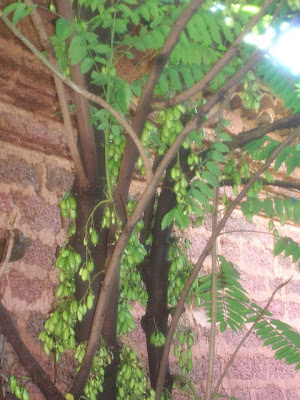 Kook/ Chinese Potato/ Koorka
Kook/ Chinese Potato/ Koorka - One of the very rarely scarcely available vegetables and one of my personal seasonal favorites when it comes to seasonal Konkani preparations. I was unable to find Chinese Potato or Kook in US. Many years later, I found cooked Chinese Potato in the frozen section termed as Chinese Potato. They were nice, quick to cook and tasted good.
Chinese Potato or Kook or Koorka as its called in Konkani language is available during particular seasons in coastal regions of Mangalore and Bangalore. Its similar to a root vegetable, blackish like a coal with rootlets and tiny roots attached, needs to be peeled and the black skin has to be removed neatly for the vegetable to be used and cooked.
The cleaning process for the vegetable is very different. The Potatoes are collected in a clean, dry gunny bag/ jute bag and the sides of the bag are enclosed in the hands, you then hit the gunny bag against the floor many a times, till the skin begins coming off on its own. Multiple repetition of this process ensures that the skin comes off; else you rub the jute bag against the surface of the Potato and peel them one by one. So, its quite a painstaking process but quite easy if one is patient enough. Many a times Mom had her entire palm blackened because of peeling requirement. Chinese Potato Upkari is a dish which was cooked and prepared at home from decades since I remember. My Grandmom also called as Ammamma fondly remembers this dish being cooked and prepared at home by her mother and aunts. My Grandma loves Chinese Potato preparations.
Picture of Kook/ Chinese Potato placed on Shiblo - Traditional Eco-friendly Utility Lids made from natural roots, creepers and fibers.
 Chinese Potato
Chinese Potato is extremely good for Diabetes patients and is a also deemed as an important healthy vegetable. It is loved a lot by mom and dad. They love the Upkari version of Kook also called as
Kooka Upkari. It is also used at times as an accompanying vegetable for various Ghashi's, Koddel's and Masala based curries. The taste of this vegetable is extremely delicious. It grows underground and requires whole lot of cleaning, peeling and cooking before it can be used. Special thanks to my Mom for providing the recipe and the pictorial. The
Chinese Potato or Kook as you see is kept on a popular Konkani household item called
Shiblo; Shiblo is a small plate made of natural tree parts, creepers and fibers; It is used for covering dishes and is utilized as a eco-friendly lid in many Konkani homes.
Recipe Source ~ Mom
Preparation time ~ 30 minutes
Ingredients:
Chinese Potato (sliced vertically) - 2 cups
Red Chillies (Byadgi variety preferred) - 3-4
Mustard seeds - 1/2 teaspoon
Curry Leaves - 6-7 leaves
Urad Dal - 1/2 teaspoon
Oil - For frying
Green Chillies (sliced) - 2
Salt - As per taste
Oil - For seasoning
Water - For boiling the vegetable
Grated coconut - 1/2 cup
Method:
Clean the Potatoes by taking the help of a rough cloth and peeling the skin of all the Potatoes. Sometimes the skin peeling technique leaves the fingers blackened. You could wear kitchen gloves should the need be. Wash them thoroughly in water and slice them vertically. This is a very common practice followed in all Konkani household where I have tasted and sampled this Upkari.
Heat oil in a saucepan, add mustard seeds and once it begins to pop, add the curry leaves and urad dal and red chillies, preferably broken into two pieces each. Give a gentle stir. Add sliced Potato pieces. Adjust salt as desired. Add enough water to completely immerse atleast 3/4th of the exposed area of the pan filled with the vegetable. Bring to boil and simmer on a low flame. Keep stirring in between. Test for doneness by tasting a small piece of it. If its done the vegetable will get evenly mashed and taste like a cooked potato. Turn off the flame after the water has evaporated and the vegetable is completely cooked.
Garnish with Grated coconut and serve hot alongwith Paej (Brown Soupy Rice). This combination is much appreciated and tried in many of my cousins house.


